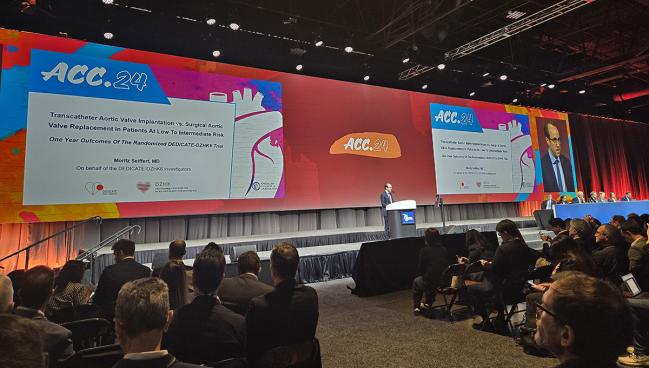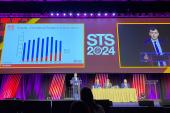Another Win for TAVI in Patients at Low-to-Intermediate Risk: DEDICATE-DZHK6
(UPDATED) The investigator-initiated study was strengthened by operators being able to choose which device to implant.

ATLANTA, GA—Once again TAVI has proved noninferior to surgical aortic valve replacement for patients at low or intermediate risk with regard to all-cause death or stroke at 1 year, according to new randomized data from the investigator-initiated DEDICATE-DZHK6 trial.
Beyond being performed without industry funding, a major strength of the study was that operators were allowed to choose the transcatheter heart valve they felt was most appropriate for the patient based on anatomy and preferences, and “this tailored approach may have improved results achieved with TAVI,” write lead author Stefan Blankenberg, MD (University Medical Center Hamburg–Eppendorf, Germany), and colleagues in the New England Journal of Medicine.
The publication was timed to coincide with presentation of the results by Moritz Seiffert, MD (University Medical Center Hamburg–Eppendorf, Germany), today during a late-breaking clinical trial session at the American College of Cardiology (ACC) 2024 Scientific Session.
To TCTMD, Seiffert say the results make a “strong argument for shared decision-making with the heart team.” However, 1-year data can only inform so much, he cautioned. “It’s really important that we look at 5-year results and also extend the time span to 10 years, because this younger, low-risk population has things like valve failure.”
“There have been concerns regarding the potential influence of industry sponsorship of medical device trials in the past,” Megan Coylewright, MD (Erlanger Health System, Chattanooga, TN), commented to TCTMD. “In some respects, it's surprising but really laudable that this consortium of researchers in Germany have gone to the effort to perform this independent comparison of TAVR versus SAVR. It's really important.”
Similarly, Tsuyoshi Kaneko, MD (Washington University School of Medicine in St. Louis, MO), told TCTMD he was impressed by the pragmatic study. “It really shows that TAVR is a very, very good therapy in this population,” he said. “It showed multiple points that it is superior compared to SAVR, and I think that sends a very strong message.”
Noninferiority With TAVI
For the study, Blankenberg, Seiffert, and colleagues randomized 1,414 patients (mean age 74 years; 57% male) with severe aortic stenosis to receive TAVI (n = 701) or SAVR (n = 713) at one of 38 centers in Germany between May 2017 and September 2022. Mean STS risk score was 1.8%, and mean EuroSCORE II was 2.1%. Patients with bicuspid valve anatomy were excluded.
“The inclusion and exclusion criteria we defined as to truly enroll a broad patient population that should mirror our daily clinical routine,” Seiffert noted during his presentation.
Within the TAVR patients, just under two-thirds received balloon-expandable bioprostheses, with the rest being implanted with self-expanding devices. In the SAVR group, 15.8% received sutureless valves. A total of 70 patients originally randomized to SAVR crossed over to the TAVI group.
At 1 year, those who underwent TAVI had a lower incidence of all-cause death or any stroke, the primary endpoint, compared those who received SAVR (5.4% vs 10.0%; HR 0.53; 95% CI 0.35-0.79), well within the noninferiority margin of a hazard ratio of 1.14. Individually, the outcome of all-cause death was significantly lower in the TAVI group compared with SAVR (2.6% vs 6.2%; HR 0.43; 95% CI 0.24-0.73), and the incidence of stroke trended lower (2.9% vs 4.7%; HR 0.61; 95% CI 0.35-1.06).
Compared with SAVR at 1 year, TAVI was also associated with higher rates of vascular access-site complications (7.9% vs 0.7%; HR 10.64; 95% CI 4.84-28.94), new-onset left bundle branch block (32.0% vs 17.5%; HR 2.03; 95% CI 1.63-2.54), and new permanent pacemaker implantation (11.8% vs 6.7%; HR 1.81; 95% CI 1.27-2.61) but lower rates of disabling stroke (1.3% vs 3.1%; HR 0.42; 95% CI 0.19-0.88), cardiovascular death (2.0% vs 4.4%; HR 0.47; 95% CI 0.24-0.86), major or life-threatening bleeding (4.3% vs 17.2%; HR 0.24; 95% CI 0.16-0.35) and new-onset atrial fibrillation (12.4% vs 30.8%; HR 0.36; 95% CI 0.28-0.46). There were numerically lower rates of MI and acute kidney injury with TAVR at 1 year.
The rate of procedural complications was similar between the TAVI and SAVR cohorts (1.5% vs 1.0%), including six TAVI patients (0.8%) whose procedures were converted to open heart surgery.
Results were maintained in multiple subgroup and as-treated analyses.
Echocardiographic parameters at 1 year were similar between the TAVI and SAVR groups, with mean aortic-valve gradients measured as 10 and 11 mm Hg, respectively, and the mean effective orifice area being 1.6 cm2 for both cohorts. Only 2.8% of the TAVI and 1.0% of the SAVR cohorts reported at least moderate regurgitation at 1 year.
As for why the mortality rate might have been so high in the surgically treated patients, given their relatively low baseline STS score, Seiffert said they are still investigating. It’s possible that the greater proportion of women in the study may have contributed as well as the COVID pandemic, which was raging during the course of the study.
‘Win for TAVI’
“Given the more rapid return to normal activity associated with TAVI, these results are a win for TAVI among patients at low surgical risk, even according to the noninferiority trial design,” writes Pinak B. Shah, MD (Brigham and Women’s Hospital, Boston, MA), in an accompanying editorial.
He agrees with the authors that a strength of the study was the operator’s ability to choose which device they wanted to use for each patient. “A greater breadth of TAVI devices is available to European operators than to US operators, which allowed for a more tailored approach to device selection and may have enhanced the outcomes in the TAVI group,” he says, adding that the greater proportion of women included in DEDICATE-DZHK6 compared with previous trials in this space also better reflects the general population.
But before these results can be applied to clinical practice, Shah cautions that longer-term outcomes data are needed. “It is important to note that not all patients who are classified as being at low surgical risk are the same,” he writes. “Patients in previous randomized trials had tricuspid aortic valves, and the mean age of the cohort in the current trial was 74 years. However, a large group of low-risk patients in real-world settings are in their early 60s and have bicuspid aortic valves, and these patients have yet to be studied in randomized trials.”
Seiffert said that his team plans to test for superiority at 5 years so long as noninferiority is still met. They would, ideally, also then expand the follow-up period to 10 years to mirror the other low-risk trials.
Patient Preference at Play
Outside of the clinical trial setting, patient preference is clearly driving procedure choice, even in young patients considered low-risk for surgery. Studies in California and New England, for example, have now shown that the prevalence of TAVI to be about equal to SAVR in younger populations.
“Although the early favorable outcomes of TAVI that were seen in the current trial are encouraging, heart teams will continue to need to balance patient preference with the current reality of the unknowns regarding the long-term outcomes of TAVI when deciding on a treatment pathway with patients,” Shah writes.
Coylewright agreed. “There is a lot of room for us to grow a cardiovascular community with regards to understanding the science of risk communication and assessment of patient preferences,” she said. “We do see quite a few patients come in asking for one thing or another, but we don't talk enough about how we respond to that. What are our skill sets? And how does it reflect the science of shared decision-making so that we are ensuring not only the patients are informed but that we are listening to their goals and values?”
Further, she continued, the importance of outcomes 5-7 years after treatment for aortic stenosis can be more or less important than those at 15-20 years for many patients. “Some of the frame around the choices made by patients with greater longevity is heavily influenced by the values of the physicians, which may be distinct from the values of the patients in front of them,” Coylewright said, adding that it is important to share all data—short- and long-term—with patients so they can make an informed decision.
Yael L. Maxwell is Senior Medical Journalist for TCTMD and Section Editor of TCTMD's Fellows Forum. She served as the inaugural…
Read Full BioSources
Blankenberg S, Seiffert M, Vonthein R, et al. Transcatheter or surgical treatment of aortic-valve stenosis. N Engl J Med. 2024;Epub ahead of print.
Shah PB. Another early win for TAVI in low-risk patients. N Engl J Med. 2024;Epub ahead of print.
Disclosures
- Seiffert reports serving on the speaker’s bureau for Amgen, AstraZeneca, BMS/Pfizer, Boston Scientific, Daiichi Sankyo, Edwards Lifesciences, Inari Medical, Medtronic, and Siemens Healthineers.
- Kaneko reports serving on the advisory board for Edwards Lifesciences and Abbott and as a consultant for Medtronic.
- Coylewright reports serving as an executive steering committee member for Medtronic's EXPAND TAVR II trial as well as receiving research funding and consulting funding from Edwards Lifesciences.





Comments